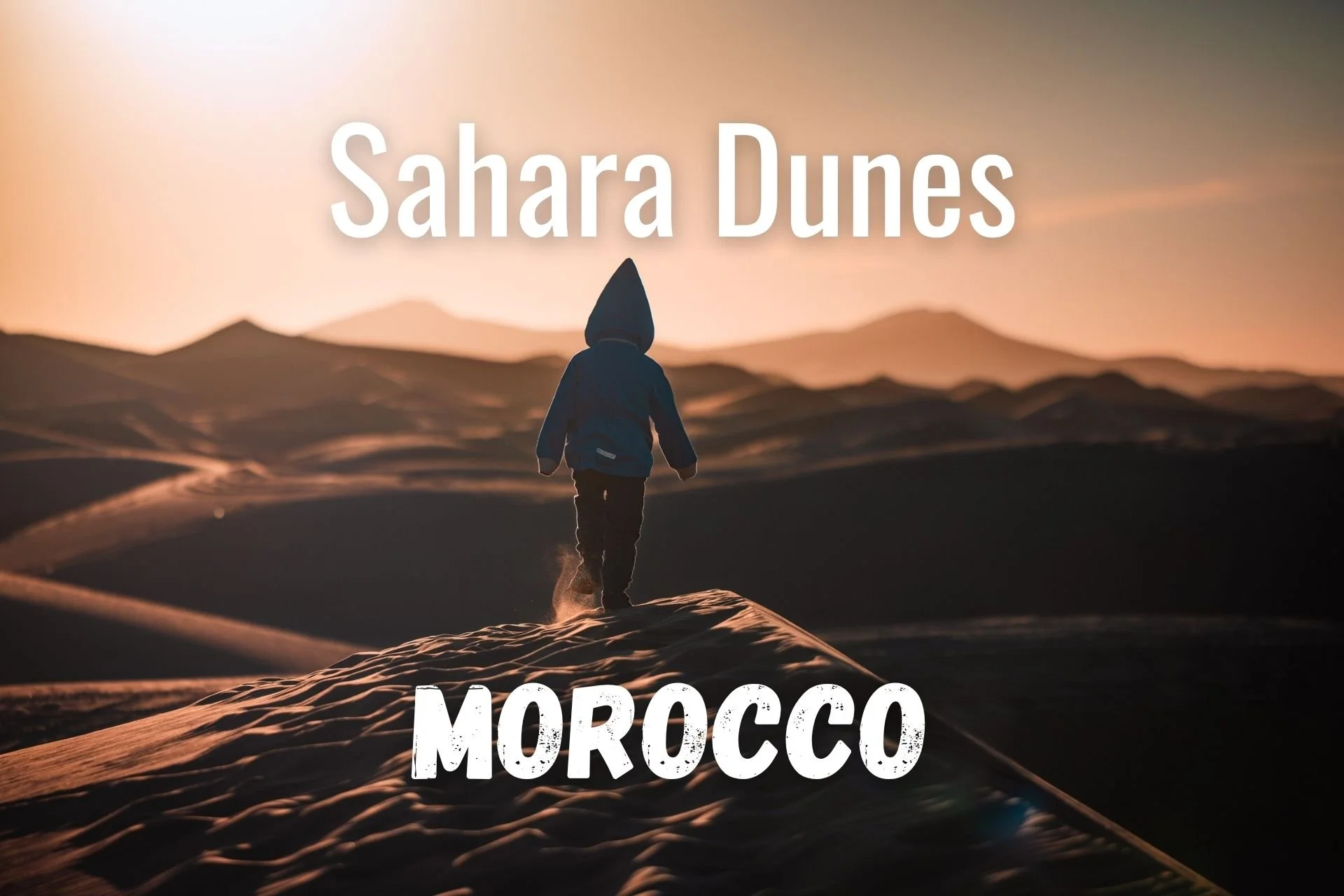Capturing the Magic through the Sahara Dunes, Road Trip Between Fes and Marrakesh
Embarking on a road trip between Fes and Marrakesh through Merzouga unveiled a tapestry of captivating landscapes, from lush green, arid terrain to golden desert, from Arabic history to Berber culture. This route offered us an immersive experience, showcasing the diversity and beauty of Morocco. If you are also considering embarking on this enchanting journey, be sure to explore these must-see stops that promise to make your journey an unforgettable adventure.
Sahara Desert in sunset
We left Fes on Day 9 of our Morocco road trip. Our planned drive was 7 hours in theory. I’ve mentioned our general rule for road trip distance when traveling with kids in my last post, but that day was the exception. We had to drive about 500km, the longest travel distance on a single day for our Morocco trip. The distance might not seem to be hugely long, but there were multiple police check points along the way, and the speed limit fluctuated between 40 and 100km per hour.
View from Kasbah Mohayut rooftop before dawn
We only made a small stop at Ifrane, a snack stop at Errachidia, and a photo stop for the camels near Merzouga. Our total travel time was 8 hours. We arrived in our desert hotel just before sunset.
Logistic Tip
If you drive from Fes, and are interested in an immediate sunset camel walk followed by staying overnight in a berber tent in the desert on the same night, you might experience a very stressful day. If you travel from Marrakesh, the drive takes even longer.
Try to break your long drive of Fes - Merzouga or Marrakesh - Merzouga into two days, depending on which direction you come from, so you can arrive at the desert town in the afternoon instead of the evening. An alternative is to fly into Errachidia if you prefer flight over road trip.
We didn’t find any unique mid-point between Fes and Merzouga, so we drove the whole way. To us, spending two nights exploring the desert was a lot more worthwhile than spending overnight in a small town along the way and cut our desert stay short.
In terms of desert accommodation, try to look for places either in Merzouga or Hassilabied. The latter is a quaint desert village on the outskirts of Merzouga, exuding an authentic charm with its traditional mud-brick architecture, providing a tranquil gateway to the majestic Sahara. Our Berber tour guide family lives there.
1. Kasbah Mohayut (Day 9)
We stayed at Kasbah Mohayut near Hassilabied. The guest house was less than 5 minutes walk away from Erg Chebbi, and a perfect first night stop for us. It has not only a nice courtyard, but also a swimming pool. Our kids were very tempted to jump into the pool but the water was a tad cold in late November.
We enjoyed our spacious and comfortable two-bedroom stay, went for a sunrise walk in the nearby Erg Chebbi sand dunes in the second morning, and drove around the nearby Merzouga. Perhaps it was late November, or perhaps everyone was busy exploring the Sahara Desert, we didn’t see many people. Other than the flying sand, everything looked so peaceful. It was quite a contrast from Fes.
2. Erg Chebbi
One of the most iconic desert destinations in Morocco, Erg Chebbi is the mesmerizing, vast expanse of golden sand dunes that seem to stretch endlessly. The best time to photograph this natural wonder is during the golden hour, either at sunrise or sunset. The play of light and shadows on the dunes, as well as its every changing shapes and forms create countless opportunities for photo lovers to capture the magic of the desert.
Sahara Desert before dawn
3. Merzouga
A small village nestled on the edge of the Sahara Desert in Morocco, Merzouga is a haven for photographers seeking to capture the mystique and allure of North Africa. From towering sand dunes to Berber culture, this desert gem offers amazing opportunities to create stunning images.
4. Berber Tent (Day 10)
Nomadic Berber tribes in Merzouga and nearby towns and villages with traditional desert lifestyle are captivating subjects for photography.
We had the opportunity to spend a day with a Berber family, who welcomed us in their home, walked us on their camels during sunrise and sunset, cooked us delicious dinner in their desert tent, shared us their life stories and music, allowing us to experience the unique aspects of their daily lives.
Definition
Berber - an indigenous ethnic group native to North Africa, primarily inhabiting regions such as Morocco, Algeria, Tunisia, Libya, Mali and Niger; the Berber people are known for their nomadic lifestyle, distinctive languages, cultures, and historical presence in the Sahara regions.
If you are not familiar with the words such as dar, kasbah mentioned in this blog, check out the “defintion” in my first Morocco post.
5. Camel Caravans
The sight of camel caravans trekking across the desert is an iconic image of Sahara Desert. Whether it's the caravan against the backdrop of the dunes or a close-up shot of these majestic animals, the camel caravans offer a timeless and authentic Moroccan experience. Even better, immerse yourself into the caravan scene, be a part of it, no matter in front or behind a camera.
6. Starry Sahara
Merzouga boasts some of the clearest night skies, providing a fantastic opportunity for astrophotography. Capture the Milky Way stretching across the desert expanse, or experiment with long exposure shots to capture the movement of the stars above the dunes.
This would be an ideal plan.
However, we had a pretty bright moon in the first half of the night. There was high wind. Our tent door kept flapping open during our sleep. I slept fully dressed with two layers of heavy blankets, and still felt cold.
I walked out of our tent a couple of times in the middle of the night, but didn’t want to risk my camera in the flying sand. So I gave up my plan. But a Milky Way shot in the desert will be on my list if I’m visiting Sahara again (see this Milky Way shot I took in Atacama Desert in Chile).
7. Kasbahs and Architecture
Explore the unique architecture of Merzouga and nearby villages, including traditional Kasbahs and mud-brick buildings. The contrast of these structures against the desert backdrop creates a visually striking scene. Pay attention to intricate details, patterns, and the warm hues of the buildings.
8. Ifrane
Often referred to as the "Switzerland of Morocco", this charming town is renowned for its alpine architecture, European-inspired design, and the Al Akhawayn University. It was a pleasant surprise to see such a lush and organized town just one hour out of Fes.
However, we only made a brief stop in front of the lion statue there, partly because we wanted to arrive in Merzouga by sunset, partly because we had traveled throughout Europe for over 4 months before Morocco. But if you want to see something different from the desert scenes and complicated medinas, consider a stop here.
Tinghir, near Todra Gorge
9. Todra Gorge (Day 11)
After Merzouga, we broke our drive from Merzouga to Marrakesh into 3 parts. On the first day (Day 11 of our road trip), we stopped at Todra Gorge and stayed at Dar Rihana Dades, a small guesthouse near Dades Gorge. The small hotel impressed us with gourmet experiences unparalleled by any other places we previously visited in Morocco. Imagine having French fine dining experience after eating almost the same traditional Moroccan dishes for more than 10 days.
Todra Gorge was a breathtaking natural wonder carved by the Todra River through the High Atlas Mountains. Towering canyon walls rise dramatically, creating a spectacular scene that's perfect for hiking or simply marveling at the awe-inspiring landscapes.
10. Dadas Gorge
Dades gorge is a striking natural wonder, where the Dades River has carved deep canyons through the High Atlas Mountains, revealing dramatic rock formations and picturesque landscapes.
On the second day (Day 12 of our road trip) after Sahara Desert, we drove through the scenic road winding through the gorge, where I took the following photo in the previous evening. The road reminded us of Transfăgărășa Road in Romania, where we had road tripped before Morocco. The latter had similar hairpin twists with a mountain scene at much larger scale.
Dades Gorge in sunset
11. Ait Ben Haddou (Day 12)
A UNESCO World Heritage site, Ait Ben Haddou is a well-preserved kasbah that boasts intricate mud-brick architecture, narrow winding streets, and panoramic views of the surrounding arid landscape.
The small hill top could be an amazing vantage point for both landscape and environmental portrait photography.
Ait Ben Haddou has also served as a backdrop for numerous films and TV productions, including “The Mummy”, "Gladiator" and "Game of Thrones."
This was one of my favorite places in Morocco. If I were to come back to Morocco, I’d like to explore and photograph Ait Ben Haddou again.
12. Tizi n’Tichka
After a night at Ait Ben Haddou, we spent our 3rd day after Sahara (Day 13 of our road trip) driving through the Atlas Mountains.
Tizi n'Tichka, the highest mountain pass in the High Atlas of Morocco, is a breathtaking and winding road that traverses rugged landscapes, offering panoramic views of the stunning mountain ranges and traditional Berber villages.
We made a few stops in the mountain drive, but could have made more. My family got sick in turn since Fes. After Sahara Desert, which was everyone’s favorite, no one seemed to be too keen on stepping out of the car. The sunset hike in Ait Ben Haddou was an exception.
On Day 13, we arrived in Marrakesh. (To be cont’d)
Click here to see the route map of our entire 17-day Morocco road trip.





















































Explore Western Sichuan's stunning landscapes and Tibetan culture in this photographer’s guide. Highlights include Genie Holy Mountain, Gong Ga Snow Mountain at sunset, and Four Ladies Mountain and many more. Discover practical photo tips in high altitude, unique Tibetan-Sichuan culture, road trip logistic tips, and prepare for high-altitude adventures in one of China’s most breathtaking regions!